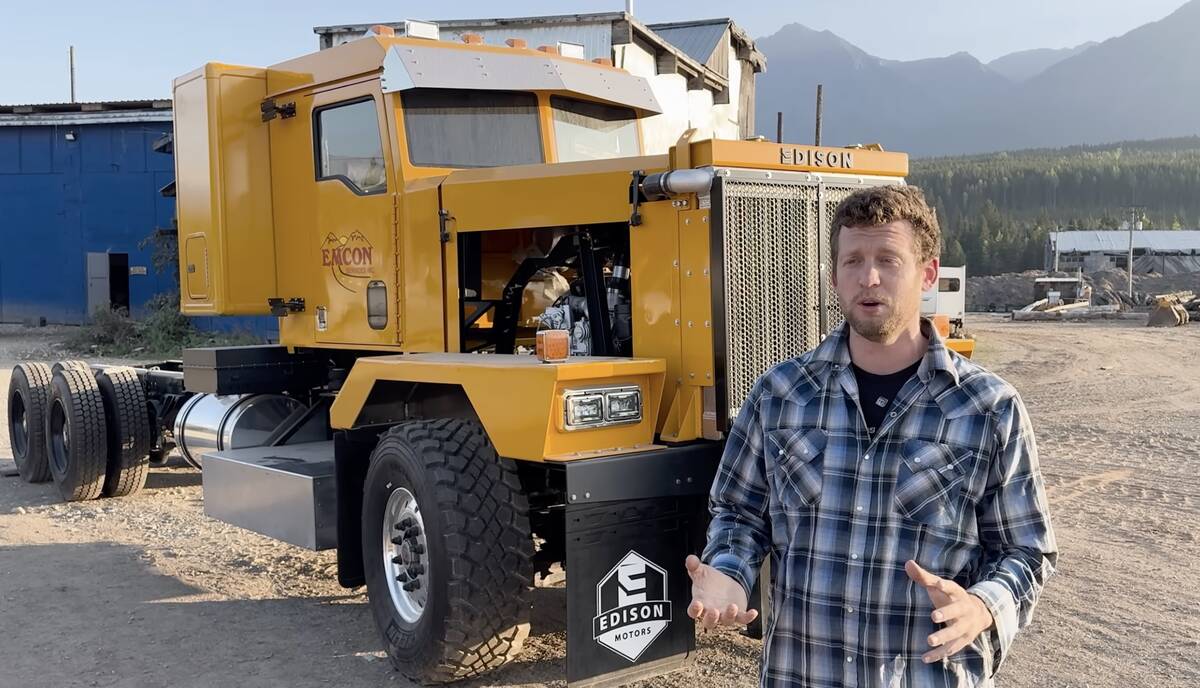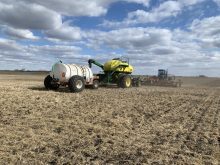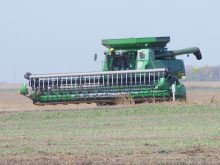Rain, rain, go away | Some climatologists think the rain may do just that — should producers prepare for a dry spell?
FARGO, N.D. — Farmers’ decisions are influenced by a factor over which they have no control — long-term weather patterns.
One obvious example of how weather affects decisions is the trend toward rubber tracks on power units and implements.
More farmers would likely spend the extra money on tracks if they knew for certain that they’re still in a long-term wet cycle.
But what if the wet cycle has peaked and the Prairies are headed back toward the kind of dry weather that historically typifies most of the region?
Read Also

Gap in emission regulations hamstrings Canadian hybrid truck manufacturer
A B.C. company building hybrid engines for heavy trucks says they have the opportunity to build something leading edge in Canada, but our own laws are stopping them from doing it.
That’s the scenario meteorologist Leon Osborne predicts to be most likely.
Osborne, one of the founders of Meridian Environmental Technology in Grand Forks, North Dakota, spends his professional life studying weather patterns.
“There are good indicators now that we’re seeing a transition to drier weather from the wet period that started in 1977,” Osborne said.
“Except for the drought years from 1988 to ’92, we’ve become progressively wetter since 1977. I think the wet cycle peaked in about 2005 or 2006. We’re now in a gradual transition toward progressively drier years.”
He said the region will remain in the generally wet cycle for a while yet, and that inadequate moisture in some parts of the Prairies last year was an anomaly.
Osborne said knowing which side of the long-term climate cycle the region is on can be important in helping farmers make equipment choices and other management decisions.
“The problem is that it’s difficult to grasp the big picture, the overall climatic trend, because you always get anomalies that go in the opposite direction of the trend,” said Osborne.
“Over time, I believe we’re going to become drier and drier, but we know there will also be major wet periods every now and then.
“For the engineers designing seeding equipment and other equipment, the only prudent course of action is to continue focusing on implements with dry weather in mind.”
He said climatologists agree that the prognosis of a prolonged dry spell will include periods of extreme moisture and periods of extreme drought, but that’s the way it has always been on the northern Great Plains.
People are often quick to point an accusing finger at El Nino, La Nina or global warming when trying to understand weather fluctuations, but Osborne said it’s not that simple.
El Nino is warming of surface waters of the eastern tropical Pacific, while La Nina is cooling of the same area.
They are nothing more than small parts of a larger pattern that only recently became recognized by climatologists as the Pacific Decadal Oscillation.
PDO is an internal reversal of two water circulation patterns that often varies from 10 to 30 years for each phase. El Nino and La Nina, on the other hand, cycle every three to seven years and are short-term blips on the chart.
Osborne said El Nino and La Nina may contribute to higher documented frequent variations in temperatures across parts of the globe. These increases in magnitudes of warming have recently supported global warming theories, but the higher temperatures alone do not necessarily relate to causes of global warming.
“We had a dramatic transition from cool phase to warm phase of PDO in 1977,” he said.
“The switch corresponds to a sharp climate transition at the same time that we experienced across the North American continent. Since then, temperature rises have served to enhance the data on the global warming profile.
“Then, nearly 30 years after the warm phase started, we saw the PDO started to transition back to a cool phase.
“The problem with documenting or proving major changes associated with the PDO is that you really don’t know for sure what has happened until years after it happened.”
Meridian performed analysis to determine the long-term effects on water resources on the northern Great Plains. The results suggest that the central part of North America is moving into a pattern of increasingly drier conditions that can last 20 to 30 years.
The area encompasses the northern Great Plains, including Manitoba, Saskatchewan and Alberta.
Osborne said his research indicates that a large part of this change will be attributed to the cool phase of the PDO.
“Prairie people will see a fundamental underlying change in structure and orientation of the polar jet stream, caused by changes in Pacific surface temperatures and circulation patterns,” he said.
“It’s normal and natural for the atmosphere to respond to changes in circulation patterns in the oceans.”
Osborne said there is ongoing debate among climatologists about whether other factors associated with global warming could override naturally occurring climatic patterns and fluctuations such as PDO or if the naturally occurring patterns take on the appearance of global warming.
“That’s the major question we’re still trying to resolve within the scientific community,” he said.
“How much of a global warming signature have we seen over the last half century, particularly over the last 30 to 40 years, that can be attributed to long-term ocean circulations caused by natural factors?
“We clearly do not know at this point in time. Oceans are never static. Deep ocean circulations and global currents change over time and we know they affect climatic changes. But we don’t know enough about these currents and how they impact the world’s climate.”
He said it will be difficult to distinguish global warming factors from naturally occurring climatic changes.
The first international geo-physical year conference met in the mid-1950s to begin discussing the entire relationship of earth, atmosphere and oceans.
Osborne said it was a good start, but nobody will begin to comprehend the overall dynamics of ocean, earth and atmosphere in just 60 years.
“Normal human nature enters into this whole equation. As humans, we have the arrogance to think we know a lot more than we really do know,” he said.
“We have a strong tendency to jump to conclusions. We want immediate answers along with quick and easy solutions, but that’s not how the real world functions.”
- equipment purchases: rubber tracked equipment vs. tires only; large, heavy combine vs. smaller, lighter combine; low vs. high disturbance seeding equipment
- land investments: buying fields with heavy vs. lighter soil; investing in drainage; investing in irrigation or in crops that need irrigation
- crop planning: moving into or away from crops such as corn and soybeans
- livestock planning: moving into or away from livestock
















